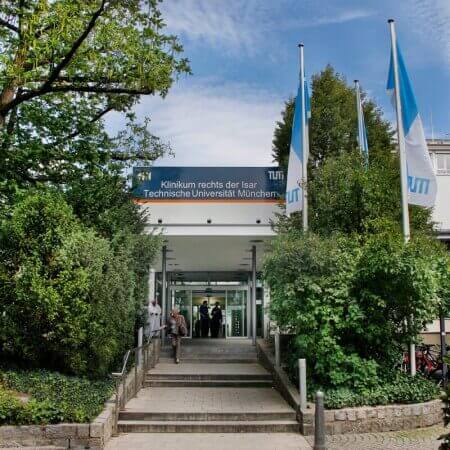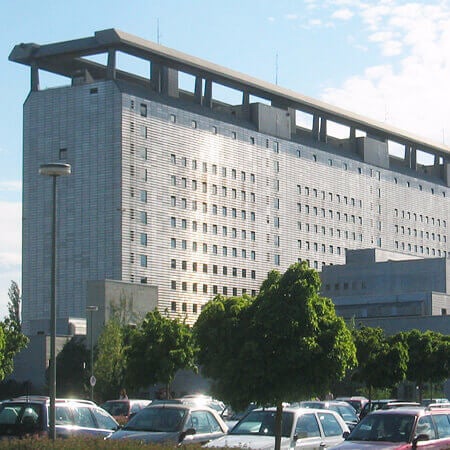A fistula between the bladder and the vagina is a through channel through which urine enters the genitals from the bladder. The disease can be successfully treated at foreign gynecological clinics. The vaginal fistula is removed, and organ defects are sutured or closed with flaps. If you develop this disease, you can undergo your treatment abroad. You can find out the cost of treatment and choose a medical care program at the best price on the Booking Health website.
Content
- Conservative treatment for vesicovaginal fistulas
- Surgical treatment
- Why to undergo your treatment abroad?
Conservative treatment for vesicovaginal fistulas
Small vesicovaginal fistulas can be treated without any operations. Basic methods are as follows:
Vesical catheterization. This procedure is indicated for small fistulas that are benign and unformed (not having an epithelized channel). Such holes can close on their own in a period of 2 weeks to 2 months. While waiting for the channel to close, a permanent vesical catheterization is performed, and a woman is prescribed anticholinergics. This approach is rarely used since the chances of closing the channel are quite low.
Coagulation methods. These treatments can be used for already-formed fistulas up to 3 mm in size. Doctors insert instruments into the bladder through the urethra and treat the channel with various energies. As a result, damaged walls are fused for up to one month. During this time, a continuous vesical catheterization is indicated. Coagulation procedures performed abroad mainly involve the use of holmium lasers. With the right selection of patients, the effectiveness of the technique reaches 80-90%. However, it is not suitable for women with a thinned vesical vaginal septum, severe inflammation, or a large fistula opening.
Fistula closure with glue. Doctors inject fibrin glue into the channel, which completely closes it and creates conditions for tissue regeneration. This procedure can sometimes be used not as a stand-alone technique but as an addition to a surgical operation. Glue is applied to the suture line to ensure healing. The procedure was first used as a stand-alone method in 1979. Until now, it has been used both in the classical version and in various modifications, for example, in combination with platelet-rich plasma injections. The results of fistula closure with cyanoacrylate glue have recently been published, but so far this is a new method that has not been sufficiently studied and is not considered standard.
Surgical treatment
Most women with vesicovaginal fistulas require surgery, as conservative methods are not always effective and only treat small channels. The operation to close a fistula is called a fistuloplasty.
Many types of operations have been developed to treat the disease. They are performed through the vagina, through a large abdominal incision, or laparoscopically (through small abdominal incisions). Some clinics also use robot-assisted surgical techniques.
Operation timing. Iatrogenic (provoked by a medical intervention) fistulas are treated as soon as possible, preferably in the first 3 days from the moment of their formation. If the fistula was formed for other reasons or was not detected immediately, and the optimal time for its immediate closure was missed, then delayed treatment would be provided. The operation is performed after the vesicovaginal fistula is fully formed, that is, 2-3 months after its development. At the time of the operation, there should be no active inflammation or tissue death. The optimal time for performing the operation for complicated fistulas is 3-6 months after their formation, while radiation-induced fistulas are operated on within a time frame of 6-12 months.
Fistuloplasty through a vaginal approach. Historically, this was the first type of operation. H. Roonhuyse was the first to close the fistula through a vaginal approach in 1663. Today, the techniques of those times are not used. Doctors suture defects in different organs separately: a vesical defect, a fascial defect, and an anterior vaginal wall defect. There are the following two surgical approaches that are considered equally effective: fistuloplasty with and without excision of the fistulous tract. However, operations with excision have one drawback: in the event of a recurrence, the repeatedly formed channel becomes larger and therefore more difficult to close.
Fistuloplasty for radiation-induced fistulas. A feature of radiation-induced fistulas is tissue deficiency. Doctors cannot just bring the edges together and suture them. They have to compensate for the lack of tissue with grafts. Surgeons take tissue flaps from various parts of the patient's body, such as the peritoneum, the gracilis muscle, the fatty tissue of the labia, the muscle tissue of the urogenital diaphragm, the skin of the buttocks, etc.
Fistuloplasty through an abdominal approach. This approach is also called transvesical because doctors make an abdominal incision and open the bladder. The technique was widely used in the twentieth century, but today it is almost never used in developed countries. Such operations are performed only in cases of a combination of vesicovaginal fistulas with ureterovaginal or vesicointestinal fistulas, as well as in cases where a vaginal approach is impossible due to anatomical features (malformations or consequences of operations). During the operation, doctors dissect the bladder longitudinally to the fistula and excise the fistulous tract within healthy tissues. They then separate the organ from the vagina and suture the defects separately.
Laparoscopic and robot-assisted fistuloplasty. These operations can be performed not only through a transvesical but also an extravesical approach (without any bladder dissection), which significantly reduces the invasiveness of the operation. Instead of one large abdominal incision, surgeons make several small incisions. The doctor's hands do not plunge into the wound. All manipulations are performed with thin and long instruments under the control of a video camera.
Treatment methods are relatively new. The first laparoscopic fistuloplasty for a vesicovaginal fistula was performed in 1994, and the first robot-assisted plastic repair was performed in 2005. The indications for these operations are similar to those for fistuloplasty through an abdominal approach. Laparoscopy is however preferable as it is less traumatic, contributes to a shorter rehabilitation period, reduces the risk of complications, and the effectiveness of the technique in centers with extensive experience reaches 98%. Performing surgery through abdominal incisions allows doctors to close defects with flaps from the omentum, peritoneum, rectus abdominis muscle, or adipose tissue in the sigmoid colon.
Why to undergo your treatment abroad?
When you have a channel formed between the bladder and the vagina, you can undergo your treatment abroad. In developed countries, the success rate of vaginal approach operations reaches 95% (compared to 85% in countries with a low level of medicine), and the risk of complications is lower. Operations through a large abdominal incision are actually a thing of the past. Laparoscopic and robot-assisted operations are performed with minimal trauma to the bladder, with an efficiency of up to 98%, and a short rehabilitation period.
You can find out the cost of treatment and choose a medical care program at the best price on the Booking Health website. We will recommend the best hospital for your treatment abroad. The cost of treatment abroad will be lower for you than if you contact a gynecological clinic directly. When making your appointment through Booking Health, the price of the program will be reduced due to the absence of taxes for foreign patients. The specialists from the Booking Health company will help you organize your trip. The initial cost of treatment will not increase after the start of your program as you will receive insurance that will cover additional medical expenses.
Authors:
The article was edited by medical experts, board-certified doctors Dr. Nadezhda Ivanisova and Dr. Sergey Pashchenko. For the treatment of the conditions referred to in the article, you must consult a doctor; the information in the article is not intended for self-medication!
Sources:
Verywell Health
NHS
The Lancet




















